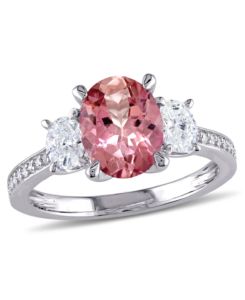If you are looking to surprise your loved one with a ring carrying a beautiful colored gem, a tourmaline ring is your best choice. The tourmaline is one of the most colorful gems you will find. The name is derived from the Sinhalese word ‘turamali’, or “mixed gems”, and the gem forms in liquid-rich environments. This gemstone has a rich story and you can click to learn about the tourmaline basics. The tourmaline is especially suited for those with a vibrant personality or a colorful sense of fashion. If there is someone special who adds a splash of color to your life, then a tourmaline ring is what you want to get.
Each color dazzles and has its own symbolic meaning. Romantic red tourmalines and pink tourmalines can make hearts swoon and beat fast. Calming blue tourmalines conjure tranquil oceans and skies. Timeless green stones evoke nature’s serenity.
There are many factors to consider when buying a tourmaline ring. No matter the color choice, a tourmaline ring signals prestige and excitement while being reasonably priced. If it falls within your budget, this marvelous gem might be exactly what you’re seeking!
What is the best color for a tourmaline ring?
The tourmaline is prominent for its colors. It shines in bright bold shades of red, blue and green; it pulses in tones of pink, yellow, and orange. Purple is rare, black is common. If you like color combinations, a tourmaline is for you: It has bi-color stones that mix different hues from pink and green to orange and brownish pink.
The most valued stones have highly vivid intense colors without any dark black areas (inclusions). The rare Paraiba tourmaline – with its popping electric blue color – is the most expensive stone, followed by the red (Rubellite) tourmaline, which often comes in shades of red to purple-red. Blue is the most common. Plainer colors are popular and command lower prices. The rule of thumb is that the more intense the color and the larger the stone, the higher the gem’s value.
Different light sources can change the mood and color of tourmalines. Blues and greens fare better under white light and daylight, and pink and red thrive under incandescent light. Be sure to view it under different sources of light when selecting your tourmaline ring.
How important is clarity for a tourmaline?
The clarity of the tourmaline refers to its inclusions, not transparency. When it forms, tourmaline traps crystals and liquid inclusions that disturb the clarity. Be assured that even though inclusions might reduce the stone’s beauty and impair its durability, it doesn’t significantly alter its price. Instead, the value of tourmaline depends more on the color than it does on clarity.
Still, you want to avoid tourmalines with dark or large imperfections that run down the middle or cloud the stone’s clarity. You can read this article on tourmaline to help you understand more when buying a tourmaline ring.
Do enhancements affect the price of the tourmaline?
As with other gems, enhancements and treatments can boost the quality of a tourmaline. If a stone is too dark, heat treatment can lighten it to an attractive color, while oiling and irradiation can hide fractures in the Rubellite. Almost all red, pink, and blue tourmalines, as well as the Paraiba and green tourmalines, receive heat treatment to strengthen the color and prevent it from fading.
How do you pick the ring carat size of a tourmaline?
It is uncommon to find large Paraiba tourmaline stones in a size over 2 carats. However, red and green tourmalines are available in larger sizes and yellow tourmaline exists in sizes as high as 10 carats.
The bigger the stone, the higher the price. But a tourmaline is valued more for its color than its size. Therefore, when you seek the right stone for your ring, you should aim for a small but lustrous gem instead of a large, darker gem.
What is the best cut and shape for a tourmaline?
As with other gemstones, there is a range of cuts available for tourmalines. The ‘cut’ does not refer to the stone’s actual shape. Indeed, there is no bearing on its quality whether it is a round or an oval shape. What matters is the quality of its cut, for it can create a huge difference.
You want a tourmaline with a nice symmetrical cut and well-placed facets that evenly reflects the light that captures its radiant splendor. Rectangle and rectangular emerald cuts can draw out and highlight the lighter tones in dark stones. If the gems were lighter, the best cuts would be oval, triangle or round. However, you want to avoid tourmalines with asymmetrical shapes that decrease the tourmaline’s brilliance.
How do you decide between one stone or accent stones?
It depends on the color of the tourmaline, your preferred design, and your budget! More stones mean higher prices but a more stunning ring. What would your loved one like? A green tourmaline ring would be more elegant when fitted with small diamond accent stones and bi-colored tourmalines are augmented by the glow of the accent stones. The choice is up to you and your fiancée. Just remember: One stone is as beautiful as a stone outfitted with accent stones.
What is the best metal for a tourmaline ring?
Certain metals bring out the stone’s color better than others do. Tourmaline matches beautifully with gold, silver or panchdhatu (an alloy of gold, silver, zinc, copper, and iron). Gold metal enhances the hues of black, brown, and blue tourmaline, green sits lovely set in yellow gold or white gold, and rose gold draws out the luminous shimmers of pink tourmaline. Think of the wearer when deciding which stone to buy.
A tourmaline engagement ring or a tourmaline promise ring?
Whether choosing an engagement ring or a promise ring, think carefully about the personality of the one wearing the ring and what you want to say. Tourmalines carry significance: For instance, a bi-colored tourmaline is popular as it represents the union of two souls as one. Focus on what you want to convey to your loved one before you purchase the ring. You can make a wise decision if you think about these before looking at the price tag.
How to care for your tourmaline ring
While very durable for daily wear, a tourmaline could be more susceptible to scratches than harder stones. Use warm, soapy water to clean your tourmaline ring regularly. You should get a professional lapidary to clean any dust deposited on the bottom of the stone and polish it annually. Heat can affect the stone but its durability is ideal if the wearer leads an active lifestyle. Generally, it is also good to periodically check if any part of a ring’s settings may have been affected.
How much does a tourmaline ring cost?
Clean stones with strong colors can fetch as much as over $5,000 per carat, while rare stones like the Paraiba tourmaline can command more than $10,000 per carat. At the same time, a small yellow tourmaline might sell for as little as $50 per carat. Red or green tourmaline rings can average between $200 and 300 per carat, while higher quality stones can rise up to $1,000 or more for small carat sizes.
Certain tones are valued higher than others. Highly saturated rare color combinations will be more expensive. Lower saturated stones (such as stormy blue-green or olive green) are lower in price. If you intend to save money on your budget, bear this in mind. What matters is this: a tourmaline ring is uniquely suited to a certain type of personality. It is affordable, its colors unsurpassable, and its loveliness undebatable. If you want to display your unique sensibilities, then a tourmaline ring will always be supreme!

